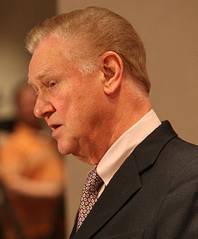Thursday, April 22, 2010 | 2 a.m.
BALANCING THE BUDGET
In addition to a $145 million deficit in the Clark County School District’s budget for the fiscal year beginning July 1, early projections show cuts of even greater magnitude in the offing. Still under consideration for fiscal 2011: 2 percent pay cuts districtwide.

Walt Rulffes
Sun archives
- Clark County teachers sweating out the budget crisis (4-22-2010)
- Clark County teachers face peer pressure on furloughs (4-9-2010)
- School Board rejects moving schools to nine-month calendar (3-26-2010)
- Year-round schools could face calendar shift to save money (3-16-2010)
- Teachers resist increasing pressure to accept pay cuts (2-5-2010)
- Budget crunch puts shorter school year, teacher pay cuts on table (2-4-2010)
- Gibbons: School districts should brace for 10 percent cuts (2-2-2010)
The $145 million budget shortfall that the Clark County School District is still trying to reconcile is not nearly as bad as the crushing deficits it will face in 2012 and 2013, according to preliminary projections.
The district says it may face deficits of $200 million to $300 million in state and local funding for each year of the next biennium.
The news comes on top of the district’s current financial plight: It has cut more than $250 million in programs, services and positions since 2008 to not overspend its $2.1 billion operating budget, and is chiseling away at another $145 million for the 2011 fiscal year that begins July 1.
“The news just keeps getting worse,” said Jeff Weiler, the district’s chief financial officer.
The Nevada Education Department is still working on its statewide projections, Superintendent of Instruction Keith Rheault said. But Clark County’s numbers are in the right ballpark, he said Wednesday.
Because of the growing budget deficit spawned by the recession’s effect on tax revenue, the amount of money per student distributed by the state to Clark County may plummet 20 percent or more, wiping out gains in per-student funding going back to 2003.
The early estimates get “much, much worse” through the next biennium and into the 2013 fiscal year, Rheault said. Federal stimulus funding that previously helped fill the hole won’t be available in 2011.
“We’re looking at projections with no additional revenues in the formula,” Rheault said. “It’s almost catastrophic.”
The funding forecast is based on preliminary projections, but Superintendent Walt Rulffes said it’s important to start the conversation so that the public — including the district’s more than 38,000 employees — appreciates the rough road ahead.
Education cuts won’t stop until parents step up and force lawmakers to properly fund schools, said John Jasonek, who recently retired as executive director of the Clark County Education Association and now serves as a consultant to the teachers union.
Given how many of the district’s programs and services have been trimmed or eliminated, there isn’t much left, Jasonek said.
“You can’t run schools this way,” Jasonek said. “With cuts of that magnitude, you’re talking about either closing schools early or drastically increasing class sizes and massive layoffs.”
To understand the implications of growing budget deficits in coming years, consider actions being taken to deal with the current fiscal crisis.
The bulk of current reductions of $145 million are being met by increasing class sizes in lower grades, putting off purchases of textbooks and classroom materials, and using reserve funds. The district is also allowing the majority of its 74 year-round schools to switch to nine-month calendars, at a savings of $15 million to $20 million.
That still leaves a $28 million gap. With personnel costs accounting for nearly 90 percent of the schools’ budget, the district is asking its employees to help make up the rest.
The district is negotiating with teachers, administrators, support employees and School Police on ways to save more money.
Rulffes said reducing employee compensation by about 2 percent across the board would cover the $28 million and save the equivalent of 400 teaching jobs. The district expects to eliminate more than 540 positions by increasing class sizes in grades 1-3.
Rulffes declined to discuss specifics of the negotiations, but did say talks with the teachers union had been “fruitful” and he was optimistic the issues could be resolved without binding arbitration.
The 2 percent pay cut could take different forms for different employee groups, Rulffes said. For teachers it might mean paying more toward their retirement costs, while administrators might be asked to take unpaid days off.
Teachers account for about 67 percent of the district’s personnel costs, compared with administrators who make up about 3 percent.
Mary Ella Holloway, past president of the Clark County Education Association, said she would prefer teachers take furlough days than salary cuts. It would be easier when the economy recovers to restore workdays than to restore the pay scale, she said.
But based on the newest budget projections, that day won’t be coming anytime soon.

Join the Discussion:
Check this out for a full explanation of our conversion to the LiveFyre commenting system and instructions on how to sign up for an account.
Full comments policy